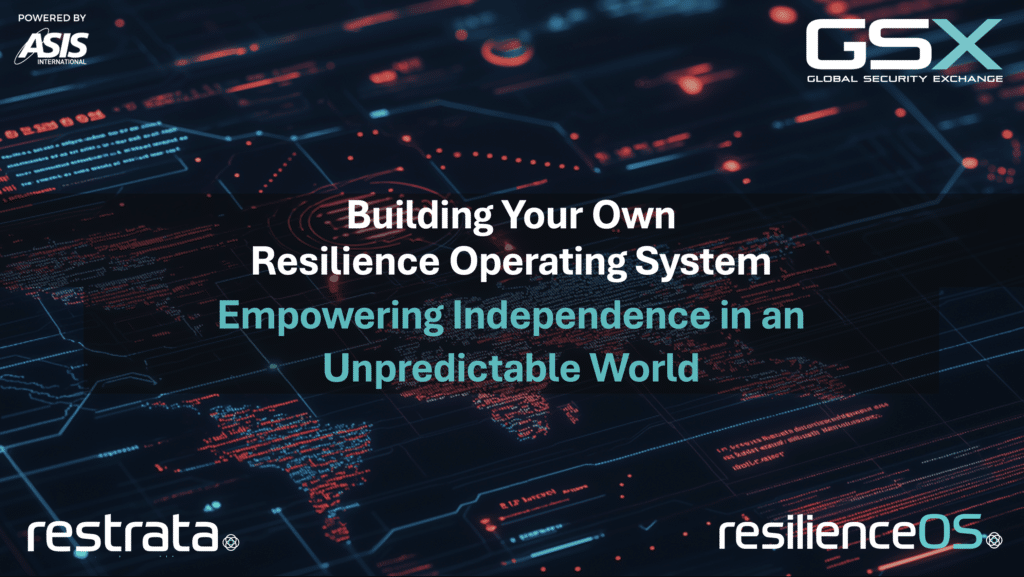In today’s rapidly changing world, unpredictability is the new normal. From geopolitical conflicts to global pandemics, organizations are constantly confronted with risks that are increasingly difficult to foresee. As threats evolve, businesses need to rethink their approach to security and resilience. In his recent speaking session at GSX 2024, the CEO of Restrata – Botan Osman, highlighted a critical paradigm shift in the resilience industry, advocating for a move away from reactive, predictive models to one that empowers organizations with real-time, actionable insights. At the heart of this shift is the concept of a Resilience Operating System, a powerful tool designed to give organizations the control, flexibility, and independence they need to face future challenges head-on.
This blog is created from the speaking session Restrata CEO Botan Osman gave at GSX 2024. If you want to watch the full recording, click here.

The Need for a New Approach to Resilience
The first key insight from the CEO’s address is that, in an increasingly volatile world, attempting to predict every potential risk is nearly impossible. Instead, the focus should be on preparation and readiness. Traditional models of risk management, which rely heavily on reactionary responses, are becoming inadequate. What is needed is a proactive approach that equips businesses to act swiftly when faced with the unknown.
One of the fundamental challenges faced by organizations today is the fragmentation of data. Many businesses rely on siloed systems that handle specific aspects of their operations—but fail to integrate these sources into one cohesive whole. As a result, when a crisis strikes, decision-makers often find themselves scrambling to piece together a clear picture of where their people and assets are, delaying their ability to act. Fragmentation, therefore, is not just an operational inefficiency; it’s a hidden threat that could be the difference between control and chaos during a crisis.
resilienceOS: A Unified Solution
A Resilience Operating System (resilienceOS) is designed to overcome this challenge. Unlike many solutions on the market that are either surface-level integrations or products of multiple acquisitions, resilienceOS is built from the ground up as a unified, open platform. At its core is the idea of putting an organization’s own data—its people, assets, and operations—at the heart of decision-making. This platform doesn’t lock businesses into specific service providers or data sources. Instead, it provides the flexibility to choose and switch providers as needed, ensuring that the system evolves with the organization.
By converging multiple data points into a single platform, resilienceOS provides real-time insights that empower businesses to make informed decisions quickly. Whether it’s knowing the precise location of employees during an emergency or integrating threat data from multiple sources, the platform acts as a central hub, offering a single source of truth. This level of integration and flexibility ensures that organizations are not only prepared to respond to crises but can do so with unprecedented speed and confidence.
Empowering Independence in an Unpredictable World
Another significant benefit of resilienceOS is the independence it offers organizations. Many systems today are built around proprietary architectures, which can limit the choice of data providers and service integrations. resilienceOS breaks this model by allowing businesses to retain ownership of their data and maintain full control over their security operations. This independence extends to the selection of service providers, whether it’s for travel risk management, location tracking, threat intelligence, and many others.
With the rise of artificial intelligence and advanced analytics, having a unified data platform like resilienceOS becomes even more critical. AI’s potential to enhance decision-making and crisis response is vast, but it requires a solid foundation of reliable data to be effective. resilienceOS provides this foundation, ensuring that when AI tools are deployed, they have access to comprehensive, real-time reliable data from across the organization.
From Fragmentation to Freedom
The shift from fragmented, reactive security models to proactive, unified resilience is essential for businesses looking to thrive in today’s unpredictable world. With resilienceOS, organizations are not just adopting another security tool; they are building an operational hub that puts them in control of their future. By integrating diverse data sources and providing the flexibility to adapt as threats evolve, resilienceOS enables businesses to operate with the freedom and confidence they need to protect what matters most—their people, their assets, and their operations.
In conclusion, as we look to the future, the Restrata CEO’s message is clear: resilienceOS is more than just a technology platform; it’s a strategic imperative for businesses that want to stay ahead of the curve. In an era defined by uncertainty, having a Resilience Operating System that empowers independence, flexibility, and real-time decision-making is not just a nice-to-have… It’s a necessity.
Organizations that invest in building their own resilienceOS today will be better equipped to face tomorrow’s challenges, no matter how unpredictable they may be.
This blog is created from the speaking session Restrata CEO Botan Osman gave at GSX 2024. If you want to watch the full recording, click here.
Interested in learning more? Book a demo today to learn how to build your own resilienceOS to protect what matters most.
